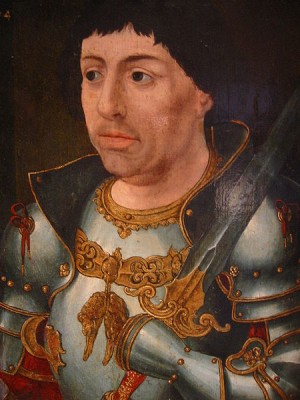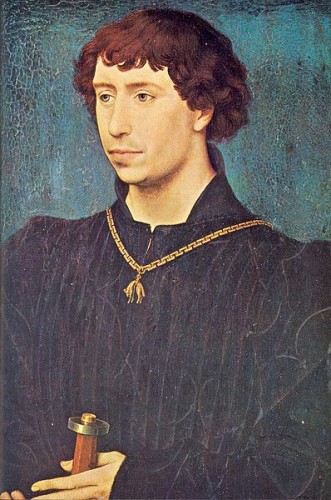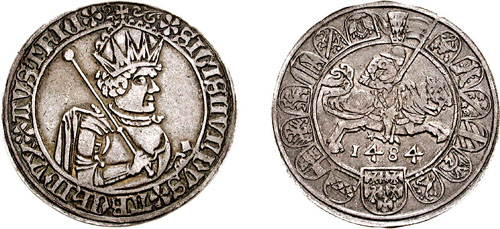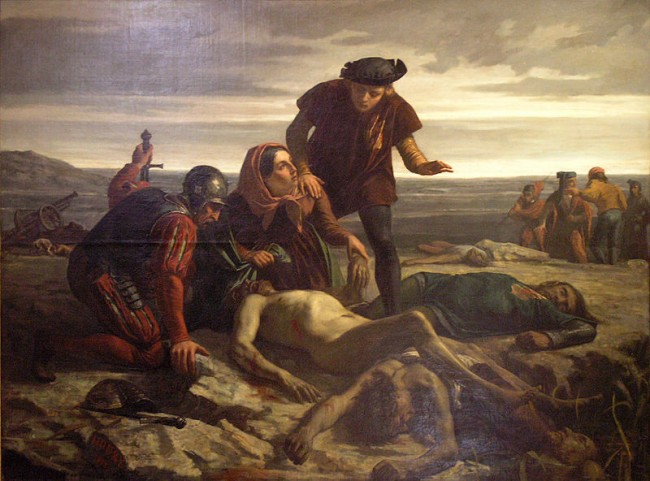Traveling within the World
Linking your favorite traveling artists across the globe
Charles the Bold, Duke of Burgundy By Susan Abernethy
Charles the Bold, Duke of Burgundy was a man born with huge potential. The child of illustrious parents, he was the heir to a vast, fertile and economically rich dukedom that stretched from the sea west to Germany. Charles could have been a king but personal flaws and failings and an inborn rage were to be his downfall. Charles was known in his time as “le téméraire” which translates from the French into “the Rash”. In English is has been interpreted as “the Bold”.
Charles was born on November 10, 1433 in Dijon. His father was Philip the Good, Duke of Burgundy and his mother was Isabel of Portugal. His initial title was the Count of Charolais and twenty days after his birth, he was inducted into the chivalric Order of the Golden Fleece. It is mentioned he was nourished by his own mother. Isabel has lost her first two children so she was extra attentive with Charles. He was to become a sturdy child, full of youthful vigor. He is described as being below average in height, stout, with a clear dark complexion and a dark beard and hair. Charles and Isabel were very close and she personally supervised his education. He was a studious pupil but really showed an aptitude for martial activities and military operations.
In 1435, Charles’ father negotiated the Treaty of Arras resulting in peace with France. Included in the treaty was a betrothal of Charles and Catherine of France, daughter of King Charles VII. A year later a formal betrothal took place at St. Omar and Catherine travelled there to be brought up by Isabel. These two were married in 1440 when Charles was seven and Catherine twelve. Charles also began to take up public duties at this time, sometimes with his mother and other times with his father. When he was twelve, he played a part in all the functions of an assembly of the Order of the Golden Fleece. Charles’ wife Catherine died in 1446.
When Charles was seventeen he was allowed to participate in his first tournament. The chroniclers were already commenting on Charles’ hot temper, impetuousness and determination to get his own way. It’s also mentioned he loved reading, the sea and boats, hunting, archery and falconry.
When Charles was twenty, his father left to go on Crusade and named Charles as his regent. Charles was eager to take up the reins of government. It was time for Charles to marry again. Isabel was pushing for an English alliance but Philip wanted Charles to marry a French bride. Isabella, the daughter of the Duke of Bourbon was in Burgundy under the guardianship of the Duchess Isabel. Duke Philip arranged the marriage, dispensing with Isabella’s parents approval and without royal approval from King Charles VII. In February of 1457, Charles’ wife Isabella gave birth to a baby girl named Mary.
Charles’ time at the helm of government allowed him to acquire an inflated sense of self importance. He tended to be impetuous and to have bouts of melancholy. His administration of ducal territories was heavy handed and didn’t win him a lot of adherents. The people of the Dukedom were happy to see the old Duke return.
From 1456 to 1461, Charles stayed away from the Burgundian court as relations between him and his father were strained. The Dauphin Louis, later King Louis XI of France was a guest at the court during this time and his presence forced Charles into third place in power and etiquette, a position he did not enjoy. Once Louis left Burgundy to become King of France in 1461, Charles’ position was restored.
 In 1465, many French nobles rose up against King Louis XI in a power struggle. Charles saw his chance to join in the warfare and mustered a small army to go to France and fight. There was a pitched battle at the small village of Montl’héry but nobody gained the advantage and Charles was wounded. There was a possibility he could have been taken hostage or killed but his men came to his rescue. Louis slipped away in the darkness and Charles proclaimed a hollow victory. The French nobles made their way to Paris to attack Louis there but their alliance fell apart and peace was made. Charles received the towns on the Somme, Guienne, Boulogne and other places and pensions.
In 1465, many French nobles rose up against King Louis XI in a power struggle. Charles saw his chance to join in the warfare and mustered a small army to go to France and fight. There was a pitched battle at the small village of Montl’héry but nobody gained the advantage and Charles was wounded. There was a possibility he could have been taken hostage or killed but his men came to his rescue. Louis slipped away in the darkness and Charles proclaimed a hollow victory. The French nobles made their way to Paris to attack Louis there but their alliance fell apart and peace was made. Charles received the towns on the Somme, Guienne, Boulogne and other places and pensions.
Charles returned to Burgundy to find his father weak and demented. While Charles was away, his wife had died and been buried. He had been singularly faithful to Isabella during their marriage. The city of Dinant had made Charles and his mother angry by questioning her faithfulness to the old Duke so Charles decided to attack the city. After six days, they surrendered but a conflagration had erupted and leveled the city. Some of the merchants and others were executed. It was to be the first instance of the wrath of Charles and its consequences on the citizenry of his dukedom. Charles continued a kind of harassing warfare until the fall and then joined his father.
In order to secure an alliance with England against France, Charles had his mother negotiate a marriage agreement for the hand of Margaret of York, sister of King Edward IV. In the first big event of his reign, they were married in June of 1468. Margaret immediately took charge of Charles’ daughter Mary and they were to remain close for the rest of Mary’s life. In the first seven years of their marriage Margaret and Charles were only together for a total period of one year. They were together fairly regularly for the first four years. After December of 1471, they only saw each other for a total of thirty two days until 1475. After July 23, 1475, they never saw each other again as Charles was away at war. Charles and Margaret never had any children. Margaret was to be a great help to Charles in administering the duchy in his absence.
In June of 1467, Philip the Good was dying and Charles was called to his bedside while he was still conscious but unable to speak. Charles begged his father to forgive him for any offences. His father squeezed his hand in agreement and died just short of his seventy-first birthday. Charles was left to continue his fathers’ struggle to turn the dukedom of Burgundy into a kingdom and to hold the balance of power between France and Germany.
While Charles was in the midst of wedding celebrations, King Louis of France was threatening to take by force the cities on the Somme Charles had acquired in 1465. Louis didn’t really want war and agreed to come to Péronne to work on a peace treaty. The negotiations lasted until a treaty was ratified in November of 1468. Charles then turned his attention to the rebellious city of Liege. He was harsh in his treatment of the city burning it to the ground, sparing only the churches.
In the spring of 1470, the Earl of Warwick, known as the “Kingmaker” arrived in France, seeking King Louis’ help to restore King Henry VI to the English throne. Louis negotiated with Warwick to fund and man the enterprise. Charles was angry and accused Louis of breaking the peace treaty of Péronne. In the summer of 1472, Charles took his troops and began fighting, taking the towns of Nesle, Montdidier and Roye, punishing the residents harshly. Two weeks after the fall of Roye, Charles’ men began the siege of Beauvais. The siege lasted for two weeks because the people of the town, including the women and children, bravely fought the Burgundians. Charles eventually lost so many men in the fight he was forced to lift the siege in humiliation. He then travelled west, burning and pillaging as he went. Eventually, on November 3, he agreed to a truce with Louis that was to last until April 1, 1473.
In May of 1469, Charles had concluded a treaty with Sigismund of Austria, cousin of Holy Roman Emperor Frederick III. The terms of this treaty satisfied Sigismund’s need for money and Charles’ ambitions for gaining territory and possibly the title of “King of the Romans”. The transaction was in fact a mortgage. Charles’ new territories included Upper Alsace and the county of Ferrette along with other fragments of territory and rights of seigniory over a few Rhenish cities. There were no records on these territories so it would be difficult to govern them and collect taxes. Efforts were made to make an appraisal of these lands but the holdings were scattered and in disarray. After four years of ineffective administration, Charles appointed Peter von Hagenbach as his deputy in charge. Because Hagenbach was a hard taskmaster he quickly acquired a bad reputation, along with his master, the Duke of Burgundy.
As early as 1470, a match between Charles’ daughter Mary and Emperor Frederick’s son Maximilian was discussed. Sigismund of Austria was an enthusiastic proponent of the match. Charles was willing to consider the match but he wanted something in return. It was within Emperor Frederick’s jurisdiction to award the title “King of the Romans” which Charles coveted. In the fall of 1473, a meeting between Charles and Frederick was set to take place in the town of Trèves to discuss these matters.
Shortly before this meeting, the Duke of Lorraine had died. Charles wanted to annex Lorraine into his territories. This item was discussed at Trèves and a treaty was signed on October 15, naming the new Duke of Lorraine a vassal of the Duke of Burgundy. After eight weeks and many delays and negotiations, it was finally agreed that Charles would be invested with the title of “King of the Romans”. There were three days of festivities, and Emperor Frederick and Charles signed a convention, postponing Charles’ coronation until February. In the early hours of the morning of November 25, Emperor Frederick departed Trèves without saying goodbye. The Duke may have been furious but he kept his cool, held a few audiences and then departed.
Sigismund had every intention of paying off the mortgage for Alsace and acquired the funds to do so with the help of King Louis XI of France on April 6, 1474. When he made his intention clear to Charles, Charles sent Hagenbach with a few hundred men to Sigismund with a refusal to acknowledge the repurchase. Within a few months, Alsace came under Sigismund’s control, the Swiss declared war on Charles and Hagenbach was captured, condemned to death and executed on May 9th. In June of 1474, Charles began the siege of Neuss. It was to last until July of 1475, when Imperial troops were threatening him and forcing him to lift the siege.
In May of 1475, after two extensions, Charles and Louis’ truce expired. Louis immediately attacked and captured some of the territory on the Somme that belonged to Charles. Also at this time, the king of England, Edward IV was planning an invasion of France. Charles offered to fight with Edward against King Louis and march to Reims where the plan was to crown Edward King of France. King Louis had other ideas. Edward was not fully committed to these plans and ended up negotiating a treaty with Louis. Louis paid Edward a huge sum of cash, a yearly annuity for a long truce and a betrothal was agreed to between Louis’ son Charles and Edward’s eldest daughter Elizabeth. Charles was furious.
At the end of 1475, Charles established a base in Nancy in Lorraine. His plan was to attack the Swiss and take the Duchy of Savoy. In January of 1476, Charles and his army assaulted Grandson. Initially, the city surrendered to him and Charles had the four hundred and twelve soldiers who had held the garrison hanged. Then the Swiss arrived. The Burgundians fell into disarray and Charles was forced to flee with just a few men, leaving behind all his artillery and treasure.
Charles’ humiliation and the effects of the campaign were beginning to take its toll on his health. He suffered from a low fever, he failed to keep food down, his legs showed signs of dropsy and insomnia plagued him. He was not fully recovered when he resumed plans to fight again. He reconstituted his army and attacked the Swiss at Murat in June. Again he was defeated. Charles was beginning to exhibit strange and unusual behavior. He had fits of hilarity. Previously eschewing alcohol, he started to drink strong Burgundy wine.
He was determined to raise a huge army and asked his estates to grant him funds in the form of a national levy. They refused. Strapped for cash he raised what army he could. In the meantime, the troops he left to guard Nancy surrendered to the Duke of Lorraine who provisioned and prepared the city for a siege. Charles began attacking in October against the advice of his generals who thought he should spend the winter raising more troops and provisions. Nancy managed to hold off the siege even though the winter was exceptionally cruel.
By the end of December, fresh Swiss troops arrived. Charles held a council on January 4, 1477. Everyone tried to dissuade him from fighting but he didn’t hesitate. He left a small force to continue the siege and took his army to a favorable plateau, strategically placing his artillery. Charles’ troops had been reduced by the siege and the winter cold. Consequently, the Swiss and German forces greatly outnumbered the Burgundians. The onslaught was fierce and Charles himself plunged into the fight. The Swiss routed the Burgundians on January 5, 1477.
A witness came forth on January 7th, saying he could identify the place where Charles fell. Charles’ body, along with his closest friends was found naked and frozen in a pool of water. His face was not recognizable. The body had been pierced with Swiss pikes and his head cleaved in two. But some who knew the Duke identified the body, recognizing his long and ingrown nails, missing upper teeth and battle scars. When King Louis XI received confirmation of Charles’ death, he proceeded to annex the Duchy of Burgundy into his kingdom.
See also: Gift exchange at the court of Charles the Bold
See also: Diplomatic aspects of Charles the Bold’s relations with the Holy See
Sources: “Charles the Bold” by Ruth Putnam, “Isabel of Burgundy: The Duchess Who Played Politics in the Age of Joan of Arc, 1397-1471” by Aline S. Taylor, “Margaret of York: Duchess of Burgundy 1446-1503” by Christine Weightman, “The Valois: Kings of France 1328-1589” by Robert Knecht
Susan Abernethy is the writer of The Freelance History Writer and a contributor to Saints, Sisters, and Sluts. You can follow both sites on Facebook (http://www.facebook.com/thefreelancehistorywriter) and (http://www.facebook.com/saintssistersandsluts), as well on Medieval History Lovers. You can also follow Susan on Twitter @SusanAbernethy2
Tags:
Replies to This Discussion
Events
-
2014 is the Chinese Year of the Horse
February 17, 2026 at 12am to February 5, 2027 at 12am – where & how you choose
Birthdays
Birthdays Today
Birthdays Tomorrow
Important (read & understand)
Skype: Travelingraggyman
Email and Instant Messenger:
TravelerinBDFSM @ aol/aim; hotmail; identi.ca; live & yahoo
OR
Travelingraggyman @ gmail and icq ***

1AWARD UPDATES & INFORMATION
10,000 votes - Platinum Award
5,000 votes - Gold Award
2,500 votes - Silver Award
1,000 votes - Bronze Award
300 votes - Pewter Award
100 votes - Copper Award
Member of the Associated Posting System {APS}
This allows members on various sites to share information between sites and by providing a by line with the original source it credits the author with the creation.
Legal Disclaimer
***************We here at Traveling within the World are not responsible for anything posted by individual members. While the actions of one member do not reflect the intentions of the entire social network or the Network Creator, we do ask that you use good judgment when posting. If something is considered to be inappropriate it will be removed
Site Meter
This site is strictly an artist operational fan publication, no copyright infringement intended
Patchwork Merchant Mercenaries had its humble beginnings as an idea of a few artisans and craftsmen who enjoy performing with live steel fighting. As well as a patchwork quilt tent canvas. Most had prior military experience hence the name.
Patchwork Merchant Mercenaries.
Vendertainers that brought many things to a show and are know for helping out where ever they can.
As well as being a place where the older hand made items could be found made by them and enjoyed by all.
We expanded over the years to become well known at what we do. Now we represent over 100 artisans and craftsman that are well known in their venues and some just starting out. Some of their works have been premiered in TV, stage and movies on a regular basis.
Specializing in Medieval, Goth , Stage Film, BDFSM and Practitioner.
Patchwork Merchant Mercenaries a Dept of, Ask For IT was started by artists and former military veterans, and sword fighters, representing over 100 artisans, one who made his living traveling from fair to festival vending medieval wares. The majority of his customers are re-enactors, SCAdians and the like, looking to build their kit with period clothing, feast gear, adornments, etc.
Likewise, it is typical for these history-lovers to peruse the tent (aka mobile store front) and, upon finding something that pleases the eye, ask "Is this period?"
A deceitful query!! This is not a yes or no question. One must have a damn good understanding of European history (at least) from the fall of Rome to the mid-1600's to properly answer. Taking into account, also, the culture in which the querent is dressed is vitally important. You see, though it may be well within medieval period, it would be strange to see a Viking wearing a Caftan...or is it?
After a festival's time of answering weighty questions such as these, I'd sleep like a log! Only a mad man could possibly remember the place and time for each piece of kitchen ware, weaponry, cloth, and chain within a span of 1,000 years!! Surely there must be an easier way, a place where he could post all this knowledge...
Traveling Within The World is meant to be such a place. A place for all of these artists to keep in touch and directly interact with their fellow geeks and re-enactment hobbyists, their clientele.
© 2024 Created by Rev. Allen M. Drago ~ Traveler.
Powered by
![]()


